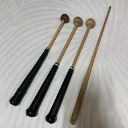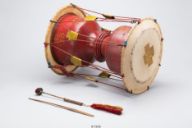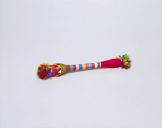Don’t judge a Puk by its cover
Even among the different types of Puk, there are mainly two varieties to each kind: the one presented in this story has been secured by a rope and is therefore recognizable as a drum used for folk music. The other form is used for court music and uses nails to secure the heads of the drum.
There are also various kinds of drumsticks producing a different type of sound: they are either shaped like a mallet with a round head (gŏngch’ae) or a flat stick made of bamboo (yŏlch’ae).
The Janggu is made of either porcelain, tile, metal, wood, gourd or tinned sheet. The round tube in the middle is called Jorongmok and its size determines the quality of the tone: the wider the tube, the deeper the sound. The two skin heads are looped onto metal hoops placed over the open ends, and this drum is always secured by rope rather than by nails. The left head (representing man) is covered with a thick hide from either a cow, a horse or a deer to produce low tones. Traditionally, this side was hit with the hand (during shamanistic rituals, for example) but it is these days more common to use the gŏngch’ae. The right side (representing woman) is covered with either dog skin or a lighter horsehide to produce higher tones and is hit with the yŏlch’ae.
The Yonggo uses two rough cowhides to cover both heads and is hit with either bare hands or with a gŏngch’ae.





